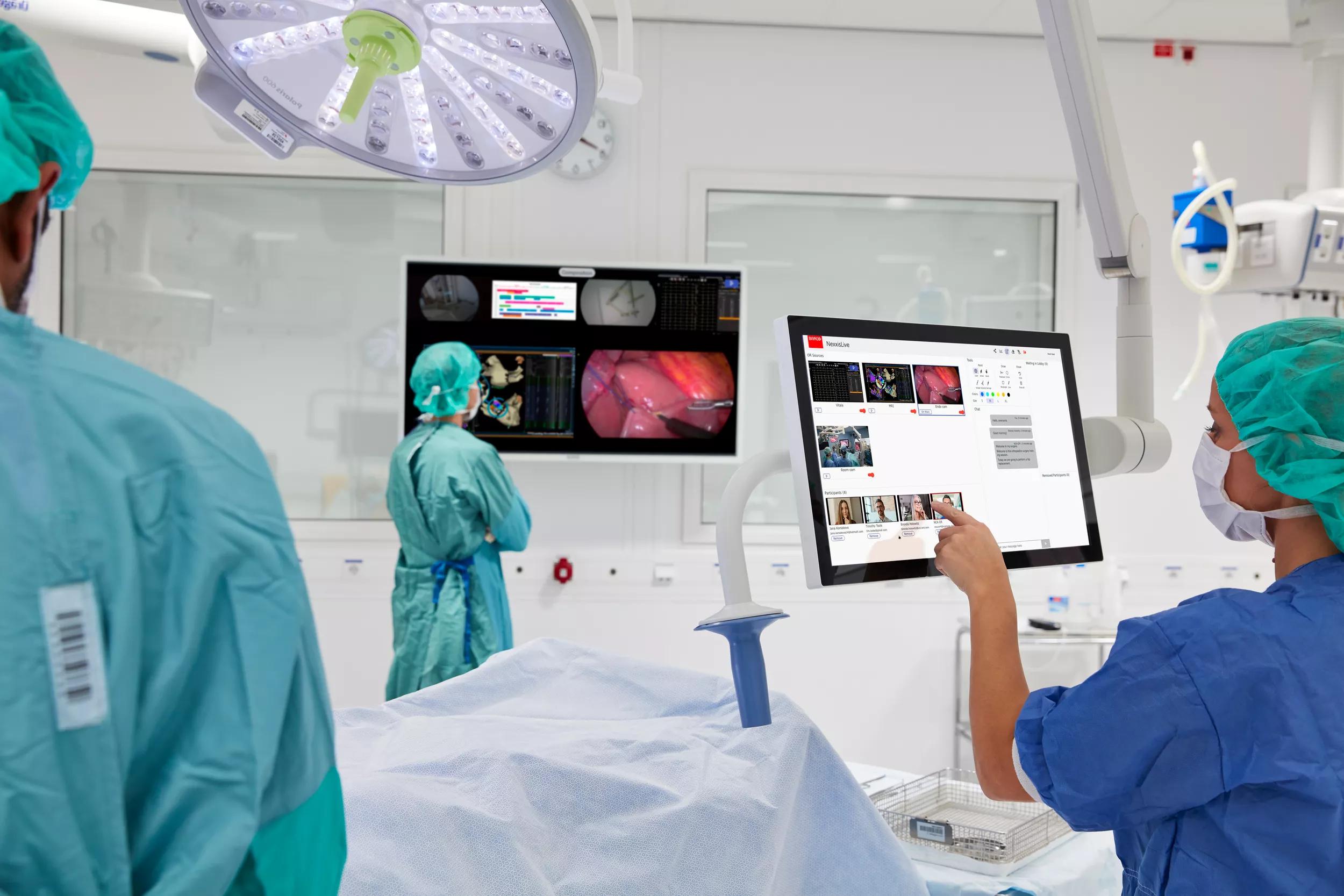Rückseite
20.05.2021
Remote surgical collaboration: 6 key questions answered for you
GESUNDHEITSWESEN Lesezeit 4 Min.
Remote surgical collaboration is on the rise. And that’s not just the result of Covid-19, the trend was emerging already before that. However, the pandemic brought along lockdowns, travel bans and restricted access to hospitals, so it did accelerate things a lot. In this article, we’re going to the basics of remote surgical collaboration. Six key questions answered!
What is remote surgical collaboration?
Remote collaboration happens when the surgeon is operating on a patient in the operating room, and other participants are joining virtually from elsewhere. You can compare it with a videocall: remote participants get to see video streams, for example from the OR’s room camera(s) and from the endoscope. The surgical team and the remote participants can communicate with each other, for example via a microphone and audio or via chat.
Of course, generic videocall software won’t do the trick for surgical teams. You can find professional solutions for surgery on the market. Look for those that ensure: a secured cloud environment, patient privacy, high-quality live video and audio, additional tools dedicated to surgery such as different types of annotation, the option to record video and capture images, and last but not least, the possibility to connect multiple sources to the platform.
Who uses remote surgical collaboration?
One of the biggest advantages of remote surgical collaboration is that it is useful in a whole variety of situations. People for whom it can be useful are:
- The surgeons themselves and their staff
- Surgical students or novices
- Surgical experts
- Surgery assistants
- Sales and service staff from integrators or medtech sales organizations

When do you use remote surgical collaboration?
Not all surgeries require remote collaboration, of course. But here are some common situations in which it could be of great advantage:
- You have a very specific case, for which you need to consult an expert who is geographically far away.
- You want to train young surgeons during their first surgeries in real-time, or evaluate them in post-op.
- You want to invite a large group of students or an expert audience for observation, but you don’t want all of them to travel or to crowd the OR, putting the patient at risk.
- Your hospital has recently bought new medical equipment for the OR, such as a robot, and your staff needs to get trained on it.
- As a technological innovator, you wish to offer global research and development teams an easier approach and more adaptable access to practical environments.
- As a sales organization of medical equipment, you wish to keep close contact with your customers and offer them immediate support when necessary.
- You wish to reduce travel and travel time for surgical interventions in your organization, as such increasing efficiency and ROI of your surgical infrastructure. Also: less travel means a smaller carbon emission footprint.
- Your hospital has many campuses and wishes to centralize surgical assistance.
- You want to spread the expertise of your hospital across affiliated institutions, or by showing complex cases at conferences.
- You wish to advance clinical trials and research through a flexible system for specific use cases.
How do you use remote surgical collaboration?
During the surgery, the surgeon can operate as usual, assisted by the staff. It’s important that surgeons can operate as they’re used to, without too many changes to how they work. A ‘gateway’ in the OR collects the different video streams (room camera, endoscope, …) and ensures that they’re sent out to the remote participants securely. This gateway might need a one-time installation in the OR, after which you should be good to go.
Remote participants can see the different video streams, and the other participants. They can talk with each other and with the OR through audio connectivity, or chat via a chatbox. A good surgical collaboration solution also offers additional telestration tools, with which the surgical team and the remote participants can indicate certain areas by drawing on the video. In this way, the surgery offers an immersive experience for all, even for those that are not physically present in the OR.

Where do you use remote surgical collaboration?
The surgeon uses it in the OR. Everyone else should be able to use it anywhere there is an internet connection. It should be easy to invite remote participants to a surgery. Because it might be urgent, right? With a good remote collaboration solution, you can set up a session in just a few clicks and invite remote participants by sending them a weblink.
That way, they can join the session anywhere and from any device, without needing to install software or apps. Mind, however, that the solution needs to protect your organization against cybercrime by guaranteeing a strongly secured environment!
Why would you use remote surgical collaboration?
Surgeons can benefit from remote surgical collaboration software to combine their brainpower with that of experts in the field, to collaborate live from the OR. A good system is also the ideal classroom environment to teach procedures, without putting patients at risk.
Students can observe more types of surgeries, everyone getting a front-row seat. Once they’re ready for hands-on training, they can get the best environment to perform their first procedures, supervised by the necessary people.
Hospital leadership teams can improve their hospitals’ reputation and ROI, thanks to a more effective use and evaluation of the OR infrastructure, more qualitative surgical outcomes, and easier collaboration with universities and other hospitals in their network.
Medtech sales and service employees can work more efficiently in supporting customers with new, or faulty, medical equipment. They can stay informed more easily by the hospitals, reduce travel time and costs, and they don’t need to be present in the OR every time they need to give a demo, training or when they need to fix an issue.

